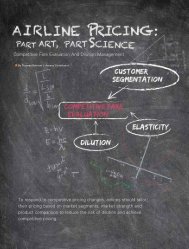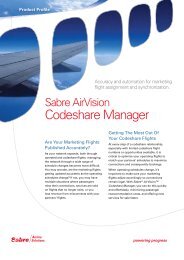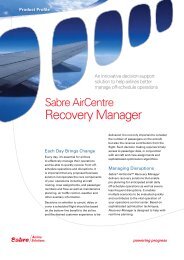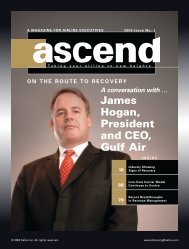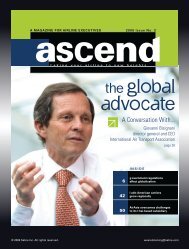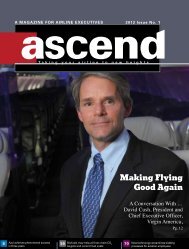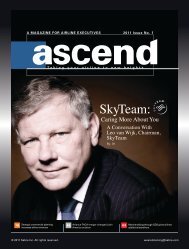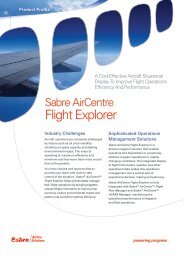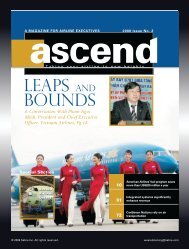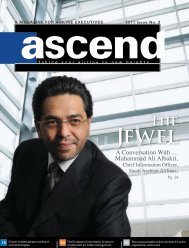2009 Issue 1 - Sabre Airline Solutions
2009 Issue 1 - Sabre Airline Solutions
2009 Issue 1 - Sabre Airline Solutions
You also want an ePaper? Increase the reach of your titles
YUMPU automatically turns print PDFs into web optimized ePapers that Google loves.
turn it into an overall positive and come out<br />
on top.<br />
One more characteristic of all of these<br />
successful carriers is a fundamental realization<br />
that they live, breathe and compete each and<br />
every day in a service industry — and that<br />
industry first, foremost and always is all about<br />
the customer.<br />
“It’s a customer-centric model that<br />
they have been able to build,” said Kannan<br />
Ramaswamy, Ph.D., a professor of management<br />
at Thunderbird School of Global Management<br />
in Glendale, Arizona, who specializes in aviation<br />
strategy research.<br />
“Among the things using this customercentric<br />
model means is that when I am incurring<br />
cost, I don’t automatically assume that it<br />
can be passed along to the customer,” said<br />
Ramaswamy. “And that, in turn, means that<br />
even though I’m differentiating my product, I’ll<br />
have to keep my costs in check in order to be<br />
able to afford the ability to give the customer a<br />
good experience. In the most basic terms, I need<br />
to be able to give my customer more for less.<br />
“So this is all about the customer experience<br />
— and Southwest [<strong>Airline</strong>s] is a very good<br />
example,” he said.<br />
Some of the techniques Southwest<br />
<strong>Airline</strong>s has been able to successfully apply<br />
over the years — such as flying a single aircraft<br />
type — are aimed directly at keeping its costs<br />
of doing business reasonably low to be able<br />
to pass lower fares on to its fiercely loyal<br />
customers.<br />
Again, however, situations arise that<br />
affect every airline, yet every carrier doesn’t<br />
necessarily handle those situations advantageously.<br />
In that case, what’s the difference that<br />
opens up avenues to success?<br />
“As an industry, there are always challenges,”<br />
said James Hogan, chief executive<br />
officer of Etihad Airways, in a March 2007 interview<br />
with the Australian Broadcasting Corp.<br />
“There are so many factors out of our control,<br />
whether it’s SARS, tsunami, war, fuel.”<br />
All these things have presented significant<br />
challenges that have affected every carrier<br />
that operates where these factors have been<br />
present. And, as Hogan said, “We’re in a business<br />
where there are so many variables that<br />
can take you off track.”<br />
Still, Hogan, who was formerly CEO<br />
of Bahrain-based Gulf Air, fully realizes that<br />
Etihad has the ability to seize certain advan-<br />
Despite many serious challenges facing the airline industry during the last decade, Abu<br />
Dhabi-based etihad Airways stands out as being one of the world’s most prominent airlines<br />
that continues to weather the storm.<br />
Photo courtesy of Airbus<br />
tages if it chooses. And in a presentation to the<br />
Wings Club in New York City, New York, last<br />
September, Hogan explained the basics of the<br />
Etihad approach.<br />
“The ‘magic three’ factors of location,<br />
investment and vision have combined to create<br />
an opportunity never seen before in the<br />
industry,” he said. “In less than 10 years, Abu<br />
Dhabi, Doha and Dubai have gone from serious<br />
players in regional aviation to major players on<br />
the global stage.<br />
“Abu Dhabi’s location offers an ideal<br />
position from which to set off to the rest of<br />
the world, placed perfectly between East and<br />
West. Indeed, if you were going to launch a<br />
new global airline, there are few better places<br />
you could choose.”<br />
In addition to geographic positioning,<br />
equipment type presents another critical factor<br />
in Etihad’s ability to succeed year after year.<br />
“Another important catalyst is the investment<br />
we have made in new equipment — and<br />
particularly in the latest aircraft technology,”<br />
Hogan said. “The new breed of long-haul and<br />
ultra-long-haul aircraft make nonstop travel<br />
from our region to all four corners of the world<br />
a comfortable and convenient reality.<br />
“Because we are ‘new’ carriers [Etihad<br />
only started flying in 2003], we are able to<br />
invest in modern, efficient and environmentally<br />
friendly aircraft, with none of the ‘legacy’<br />
issues affecting the more-established industry<br />
players today.<br />
“And finally, we have vision: the vision<br />
of Abu Dhabi’s leadership not just in creating<br />
a travel hub, but in developing a focal point for<br />
the wider aviation industry — all part of the<br />
ongoing effort to diversify our economy in the<br />
future.”<br />
In the same speech, Hogan addressed<br />
several other questions about issues Etihad<br />
has faced during its mounting successful climb<br />
to prominence.<br />
“Let me explode a few urban myths,”<br />
Hogan said. “We do not receive government<br />
subsidies or guarantees, and neither do we<br />
benefit from free or discounted airport and fuel<br />
costs. We hedge fuel. We borrow money from<br />
financial markets. There are no ‘free kicks.’<br />
“Our shareholders — the investors of<br />
this region — demand accountability, a return<br />
on investment and a well-run business. And we<br />
have a real and genuine commercial mandate<br />
— a mandate that will see us break even over<br />
the coming years despite heavy investment in<br />
new aircraft and on new routes.”<br />
Those routes include some of the most<br />
exciting possibilities in the world of air transportation<br />
today, such as one-stop trips from<br />
Australia through Abu Dhabi to London, or the<br />
same single stop from Australia to New York.<br />
The globally central location of the Middle<br />
East — and the massive investment in aviation<br />
infrastructure that is occurring there — provide<br />
Etihad a solid foundation to achieve multiple<br />
ascend<br />
61<br />
special section



